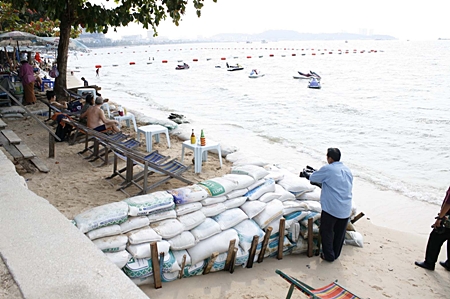Three days after being told Pattaya Beach will disappear into the sea within five years without government intervention, Pattaya Deputy Mayor Ronakit Ekasingh and Banglamung District Chief Mongkol Thamakittikhun went down to the seashore to see just how bad things really are.
Both men expressed surprise and dismay Monday at how much the beach had eroded. In North Pattaya, few options were apparent to conserve the beach and keep it in at least controllable shape. Sand has been reduced to a narrow strip and even trees are struggling to hold on to their ground.
 Sandbags are only a temporary measure to try and stem the erosion.
Sandbags are only a temporary measure to try and stem the erosion.
In a report that generated worldwide headlines, Professor Thanawat Jarupongsakul, head of the university’s disaster studies program at Chulalongkorn University, told local and state politicians Jan. 21 that erosion has shrunk Pattaya’s once-impressive beach to as few as five meters wide. If nothing is done, the sand will be swept completely out to sea within the decade.
The damage is worst near the Dusit Thani Hotel, where one beach chair vendor told the pair she used to have enough sand to place 40 chairs on her leased plot. Today, she can only accommodate four. For all intents and purposes, her business has been destroyed.
Ronakit said the problem had been evident for a long time but the city has “been doing its best” to remedy it. The statistics, however, don’t back that up.
Thanawat’s report said that in 1952, Pattaya Beach covered 96,128 sq. m. and was 36 m. wide. Erosion cut that 49,919 sq. m. by 1975.
Pattaya’s explosion as a tourist center and the uncontrolled development that came with it actually resulted in the entire beachfront disappearing during the 1992-1993 storm season. Only emergency measures managed to restore the sand to 18 m. wide over 50,500 sq. m. by 2002.
Today, however, rampant exploitation of beach resources and unchecked erosion has again resulted in some parts of Pattaya Beach now having only 5 m. of sand.
Experts say the government must spend up to 600 million baht to save the beach by refilling it with 200,000 cu. m. of dredged sand. The project outlined by Chulalongkorn would widen the beach again to 30 m.
Ronakit, however, said he believes more studies are needed before the government can spend that amount of money. In the interim, he said, the city might have to allow beach vendors to take that part of the beach currently reserved for public use, which runs counter to a province-wide law.
Mongkol lamented that the beach problem is a result of both nature and humans taking their toll. People, he said, exploited the beach too much for their own ends and now nature was serving up retribution, sweeping the beach out to see in the winter and depositing it back in other places during the summer months.
That cycle, however, has become unpredictable, he said. There’s no time to waste now, Mongkol added, or Pattaya’s signature landmark will be gone forever.




